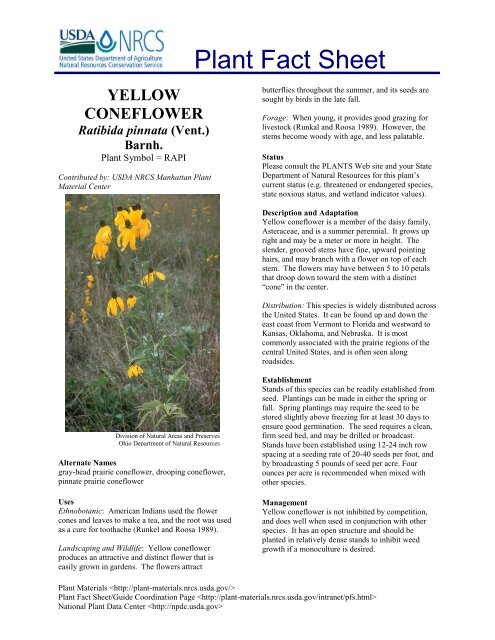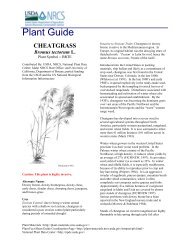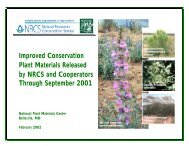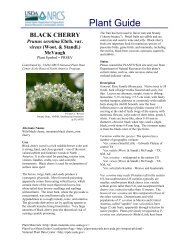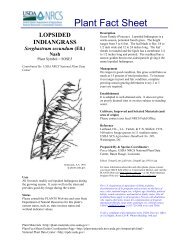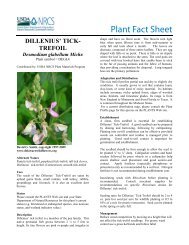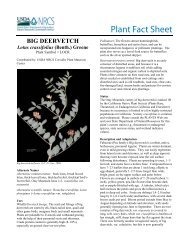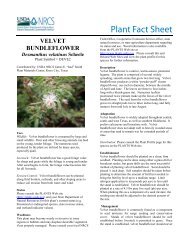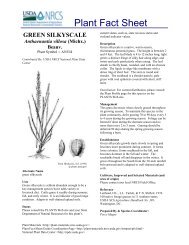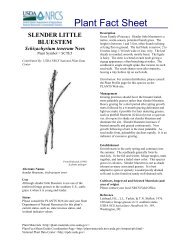PDF fact sheet - USDA Plants Database - US Department of ...
PDF fact sheet - USDA Plants Database - US Department of ...
PDF fact sheet - USDA Plants Database - US Department of ...
You also want an ePaper? Increase the reach of your titles
YUMPU automatically turns print PDFs into web optimized ePapers that Google loves.
YELLOW<br />
CONEFLOWER<br />
Ratibida pinnata (Vent.)<br />
Barnh.<br />
Plant Symbol = RAPI<br />
Contributed by: <strong><strong>US</strong>DA</strong> NRCS Manhattan Plant<br />
Material Center<br />
Division <strong>of</strong> Natural Areas and Preserves<br />
Ohio <strong>Department</strong> <strong>of</strong> Natural Resources<br />
Alternate Names<br />
gray-head prairie coneflower, drooping coneflower,<br />
pinnate prairie coneflower<br />
Uses<br />
Ethnobotanic: American Indians used the flower<br />
cones and leaves to make a tea, and the root was used<br />
as a cure for toothache (Runkel and Roosa 1989).<br />
Landscaping and Wildlife: Yellow coneflower<br />
produces an attractive and distinct flower that is<br />
easily grown in gardens. The flowers attract<br />
Plant Fact Sheet<br />
butterflies throughout the summer, and its seeds are<br />
sought by birds in the late fall.<br />
Forage: When young, it provides good grazing for<br />
livestock (Runkal and Roosa 1989). However, the<br />
stems become woody with age, and less palatable.<br />
Status<br />
Please consult the PLANTS Web site and your State<br />
<strong>Department</strong> <strong>of</strong> Natural Resources for this plant‟s<br />
current status (e.g. threatened or endangered species,<br />
state noxious status, and wetland indicator values).<br />
Description and Adaptation<br />
Yellow coneflower is a member <strong>of</strong> the daisy family,<br />
Asteraceae, and is a summer perennial. It grows up<br />
right and may be a meter or more in height. The<br />
slender, grooved stems have fine, upward pointing<br />
hairs, and may branch with a flower on top <strong>of</strong> each<br />
stem. The flowers may have between 5 to 10 petals<br />
that droop down toward the stem with a distinct<br />
“cone” in the center.<br />
Distribution: This species is widely distributed across<br />
the United States. It can be found up and down the<br />
east coast from Vermont to Florida and westward to<br />
Kansas, Oklahoma, and Nebraska. It is most<br />
commonly associated with the prairie regions <strong>of</strong> the<br />
central United States, and is <strong>of</strong>ten seen along<br />
roadsides.<br />
Establishment<br />
Stands <strong>of</strong> this species can be readily established from<br />
seed. Plantings can be made in either the spring or<br />
fall. Spring plantings may require the seed to be<br />
stored slightly above freezing for at least 30 days to<br />
ensure good germination. The seed requires a clean,<br />
firm seed bed, and may be drilled or broadcast.<br />
Stands have been established using 12-24 inch row<br />
spacing at a seeding rate <strong>of</strong> 20-40 seeds per foot, and<br />
by broadcasting 5 pounds <strong>of</strong> seed per acre. Four<br />
ounces per acre is recommended when mixed with<br />
other species.<br />
Management<br />
Yellow coneflower is not inhibited by competition,<br />
and does well when used in conjunction with other<br />
species. It has an open structure and should be<br />
planted in relatively dense stands to inhibit weed<br />
growth if a monoculture is desired.<br />
Plant Materials <br />
Plant Fact Sheet/Guide Coordination Page <br />
National Plant Data Center
Pests and Potential Problems<br />
Birds will feed heavily on the seed heads <strong>of</strong> this<br />
flower in the fall <strong>of</strong> the year. This is advantageous<br />
for the wildlife watcher, but maybe a potential<br />
problem for those growing this species for seed<br />
production.<br />
Cultivars, Improved, and Selected Materials (and<br />
area <strong>of</strong> origin)<br />
„Sunglow‟ – (Kansas) Sunglow was released in 1978,<br />
and has shown to have excellent vigor. This cultivar<br />
is especially adapted to the central United States. Its<br />
range includes portions <strong>of</strong> South Dakota, Minnesota,<br />
Nebraska, Iowa, Missouri, Illinois, Kansas,<br />
Oklahoma, and Arkansas. This plant material is<br />
readily available from commercial sources.<br />
Prepared By & Species Coordinator:<br />
R. Alan Shadow<br />
<strong><strong>US</strong>DA</strong> NRCS Manhattan Plant Material Center ,<br />
Manhattan, Kansas<br />
Edited: 20July2005 rln; 060816 jsp<br />
For more information about this and other plants, please contact<br />
your local NRCS field <strong>of</strong>fice or Conservation District, and visit the<br />
PLANTS Web site or the Plant Materials<br />
Program Web site <br />
The U.S. <strong>Department</strong> <strong>of</strong> Agriculture (<strong><strong>US</strong>DA</strong>) prohibits<br />
discrimination in all its programs and activities on the basis <strong>of</strong><br />
race, color, national origin, sex, religion, age, disability, political<br />
beliefs, sexual orientation, and marital or family status. (Not all<br />
prohibited bases apply to all programs.) Persons with disabilities<br />
who require alternative means for communication <strong>of</strong> program<br />
information (Braille, large print, audiotape, etc.) should contact<br />
<strong><strong>US</strong>DA</strong>'s TARGET Center at 202-720-2600 (voice and TDD).<br />
To file a complaint <strong>of</strong> discrimination write <strong><strong>US</strong>DA</strong>, Director, Office<br />
<strong>of</strong> Civil Rights, Room 326-W, Whitten Building, 14th and<br />
Independence Avenue, SW, Washington, DC 20250-9410 or call<br />
202-720-5964 (voice or TDD). <strong><strong>US</strong>DA</strong> is an equal opportunity<br />
provider and employer.<br />
Read about Civil Rights at the Natural Resources Convervation<br />
Service.


